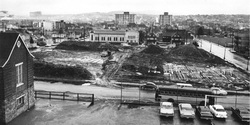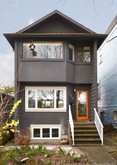|
(HOMEEDIT.COM) Blackboards or chalkboard walls are very versatile and can be used functionally but also for decorative purposes. You can integrate them in every room of the house even take them outdoors. Use them for writing messages on, notes, recipes, grocery lists, draw something beautiful on them or let the kids doodle and have fun with them. Wherever you decide to have such a feature, there are numerous different ways in which to use it and we have compiled a list of examples and ideas for you to take a look at.  In December of 1968, the residents of one of Vancouver’s oldest neighbourhoods, Strathcona, were faced with losing their neighbourhood. Whole city blocks were razed to make room for public housing and the first phase of a massive freeway project, but the residents of Strathcona were not prepared to simply watch as their neighbourhood was destroyed around them. After losing several blocks, the community rallied together and took a stand against further demolition by forming the ‘Strathcona Property Owners and Tenants Association’ or SPOTA. As an organized community group, SPOTA took on the City planners, catching the attention of Robert Andras, the federal minister in charge of housing. After meeting with SPOTA, Andras put an immediate halt to the City’s development plan. From that point on SPOTA was included in the planning process and Strathcona saw a resident-approved rehabilitation with new parks, buildings, streets, sidewalks and a community centre.  Part of that major rehabilitation involved rebuilding the demolished blocks with replacement housing. The Strathcona Area Housing Society, SAHS, was created and a development plan of infill housing was adopted to be completed in four phases between 1974 and 1982. Architect Joe Wai, then of Thompson, Berwick, Pratt and Partners, was responsible for 51 units in the first three phases as well as 120 units at the Mau Dan Cooperative Housing Project.  The homes that Joe Wai created have been dubbed the ‘Joe Wai Special’. Similar to its namesake, the Vancouver Special, Wai’s homes were built quickly in response to housing demand. The pitched roof and flat façade gives it a similar outward appearance to that of the typical Special. However the Joe Wai’s profile is slightly taller and more narrow, to better fit in with the Strathcona streetscapes. While the interior is similar to that of the traditional Special, the narrow profile of the homes meant for a slightly different floor plan that often included a central kitchen with hallways on either side. While Vancouver Specials can be found all over the Lower Mainland, Joe Wai’s Specials are unique to Strathcona.  The Joe Wai Special has become a popular commodity in Vancouver’s real estate market, and the few that have come up for sale, don’t typically take long to sell. Their important link to Vancouver’s history, coupled with an adaptable design makes them prime for sympathetic renovations that retain their original intent and character while updating to a modern family home. Learn more about Joe Wai’s Specials!
‘Special’ Insight: Two Distinct Perspectives on the Vancouver Special April 16th 7:30pm – 9pm $12 Joe Wai speaks about the Strathcona Story and the unique homes he designed to rebuild the community. Vancouver Special House Tour April 26th 1pm – 5pm $30 Tour inside 5 renovated Vancouver Specials including the renovated Joe Wai in Strathcona (pictured above). Additional Reading: Yuri Artibase on the Joe Wai Special (2012) VHF’s pdf on the history of SPOTA The story of Mary Lee Chan  DERRICK PENNER (VANCOUVER SUN) VANCOUVER — A single house in Vancouver is no longer a single house in the age of eco-density. With property prices in the stratosphere and the city under pressure to encourage more affordable forms of housing, most single family homes can potentially be three housing units — a main house with a secondary suite, then a separate laneway suite. And as the city completes more of its neighbourhood plans, single family lots can become something else entirely as developers assemble properties to turn them into higher density multi-family townhouses or mid-rise apartments. “I think the focus that the city has placed on affordable housing and what they’re doing in other areas opens up the discussion at the city in terms of alternate forms of development,” said architect Larry Adams, principal at the Vancouver firm NSDA. The move toward densification is most visible along streets such as Cambie or around Oakridge Centre, where it’s the city’s priority. Seeing what is happening there has definitely “piqued people’s interest” in the potential for continuing it along other arterial streets in other areas of the city, Adams added. His firm is working on a rezoning proposal to turn three lots zoned for two-dwelling use at First Avenue and Victoria Drive into a 26-unit housing complex designed as an “intentional community,” which would include social housing. Adams called the site something of a “poster child” for higher density, because although the lots are surrounded by single-family homes, they are used as parking by the Grandview Calvary Baptist Church and are at a high-traffic intersection. The process, however, hasn’t become any less complex, Adams said, and hasn’t become an easier sell in single-family neighbourhoods. Proposals for land assemblies of single-family lots for multi-family rezoning have recently begun to hit the city’s planning department in the Norquay Village neighbourhood surrounding Kingsway and Slocan Street in East Vancouver, according to Brian Jackson, the city’s general manager of planning and development. Jackson said the city wants to encourage row housing and stacked townhouses in that area — housing types that are less common than houses and condos. The city is pleased with the types of townhouses being built on the Cambie and Granville Street corridors, noting “housing innovation happens at the high end.” The city approved a new Norquay neighbourhood plan in 2010, and to help applications along, Jackson said they’ve “pre-zoned” most of the neighbourhood’s blocks to accommodate higher-density uses. And this is where he wants to see similar housing types, but at a much lower cost. “There are creative ways of increasing density in our single-family neighbourhoods,” Jackson said. “And the city has done that by allowing three units on almost every single-family lot in the city of Vancouver.” The laneway house is the most visible manifestation of that effort, and Jackson said more than 1,100 have either been built or are going through the planning process since the policy was approved in 2009. Such developments should give homeowners the incentive to do some research about the potential for their single-family home when they are considering selling, according to realtor Geraldine Santiago. “If you only have one property, you want to maximize it,” said Santiago, a realtor with Re/Max Crest Realty Westside. Santiago held a seminar recently for homeowners on subdividing and rezoning — titled Subdivide and Conquer — to test the waters of public interest. She said the event attracted close to 20 people, and there were several realtors in the crowd. The key point of her seminar was for homeowners to know the exact size of the lot their house sits on and what its specific zoning is, so they can determine what is allowed on the property. “The most important asset you have right now is your lot,” Santiago said, noting the physical improvements on the lot — the house — eventually depreciate. And Santiago said the development potential for land assemblies isn’t always in large-scale, multi-family projects. Smaller builders might be interested in pursuing duplexes in some single-family zones. However, there are limits to the city’s willingness to expand higher-density options, according to Jackson. Jackson said the city’s preference is to work in locations that are covered by updated plans or specific policy, such as Oakridge, Norquay and Marpole. Outside of those areas, Jackson said planners are discouraging land assemblies along arterial streets until updated plans are in place. Adams said single-family neighbourhoods are typically resistant to changes that bring higher density housing, although the city does need change. “I don’t think every single single-family lot is right for development,” Adams said. |
Market UpdateUpdates on Real Estate news happening in your city. Archives
January 2024
Categories
All
|
